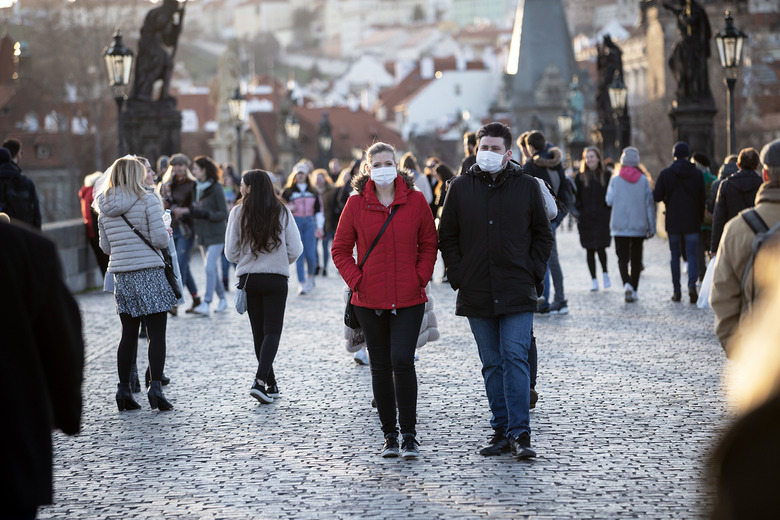These 5 States Already Have New Lockdowns As Coronavirus Cases Skyrocket
- Some states are starting to implement tighter coronavirus restrictions to prevent a further spike in new cases and deaths.
- While some cities are banning indoor eating and bars from operating, other cities have started to implement curfews.
- States currently getting hit hard by new coronavirus cases include Michigan, Wisconsin, and Rhode Island.
The coronavirus is surging across the country and the reality is we're not returning to a pre-coronavirus lifestyle anytime soon. What's especially worrisome is that the rise in new coronavirus cases isn't solely a function of increased testing. On the contrary, the massive spike in new coronavirus infections is being accompanied by a worrisome rise in hospitalizations and deaths. The coronavirus death rate over the last two weeks has jumped by 13% across the country as a whole. And some states — like Wyoming and Illinois — have seen their death and hospitalization rates skyrocket by nearly 60%.
With the coronavirus on the rise, not to mention projections that things will only get worse over the next few 2-3 months, many cities are starting to implement tighter restrictions designed to prevent the coronavirus from spreading far and wide. The new restrictions — which in some states involve the shut down of bars and a ban on indoor seating — has naturally been met with some resistance by some. Still, the rationale behind tighter restrictions makes sense given Dr. Fauci's recent remarks which attribute the rise in coronavirus cases to people in the U.S. not avoiding crowds.
"Unfortunately for the United States," Fauci said, "we have been hit more hard than virtually any other country on the planet. The United States did not shut down as a country as much as the European Union did."
All that said, below is a look (via EatThisNotThat) at which states and areas are starting to revisit lockdown measures that were initially put in place back in March and April.
First up, we have Massachusetts which has seen a number of communities implement tighter restrictions. To this end, NBC Boston reports:
More than a dozen communities in Massachusetts are reverting back to Step 1 of Phase 3 of the state's reopening plan after being designated as high-risk communities for three weeks now.
Some of these businesses just opened a few weeks ago under the state's guidelines and now, today, will have to close yet again.
The state releases its weekly reports based on 14 days of information. There are 13 cities and towns that fall under that category including Chelmsford, Holyoke, Malden, Kingston, Randolph and Woburn.
Various counties in and around Chicago are also implementing tighter COVID-19 restrictions. According to new guidelines that previously went into effect in suburban Cook County and will soon go into effect for the entire city of Chicago tomorrow, bars that don't serve food will have to close once again. Further, indoor seating will no longer be allowed and outdoor seating will have to end by 11 PM each night.
ABC7Chicago adds:
Gov. JB Pritzker said the mitigations were triggered in Chicago by seven straight days of hospital admission increases and eight consecutive days of rising test positivity. In Chicago, the number of non-ICU patients is up 72% since late September and the number of those in ICU is up 56% since October 1.
Another city poised to introduce new lockdown measures is Newark, New Jersey. With the coronavirus spreading rapidly in the area, all non-essential businesses will now have to close up shop by 8 PM. What's more, some businesses like salons will only be able to operate on a reservation basis. Outdoor dining in the city, meanwhile, has to shut down by 11 PM.
On a related note, there are rumblings that the lockdowns in Newark may eventually be applied to the entire state.
Michigan is another state where the coronavirus is on the rise. And while the Governor there is hoping to avoid another lockdown across major cities, tighter restrictions are already being implemented in the Upper Peninsula area.
Fox2Detroit reports:
The governor's office sent out a news release Friday afternoon saying Gov. Whitmer had signed an executive order that moves the region from Phase 5 back to Phase 4. The executive order goes into effect Friday, Oct. 9.
The rollback will require people who can perform work remotely to do so, require schools to enforce mask requirements with limited exceptions and place limits on social gatherings and stores that match those in place in most of the state, among other changes. You can see a list below.
Lastly, El Paso, Texas recently implemented a 10 PM to 5 AM curfew. The stay-at-home order from Judge Ricardo Samaniego was accompanied by a remark that the city is in "a crisis stage."
Looking ahead, it won't be surprising to see tighter lockdown measures implemented across the board. With the coronavirus more likely to spread in indoor settings and in cooler temperatures, tightening restrictions now could help prevent an even bigger spike in the near future.
